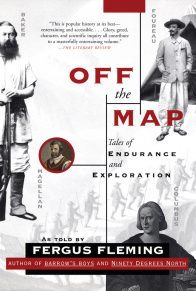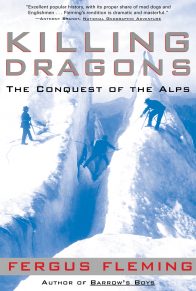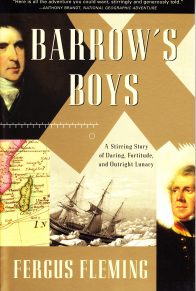There are five North Poles: the North Geographical Pole, the absolute, fixed cap of the globe; the North Magnetic Pole, to which our compasses point, and which is not stationary but rambles at present through the Canadian Arctic; the North Geomagnetic Pole, which centres the earth’s magnetic field and sits today over north-west Greenland; the Northern Pole of Inaccessibility, a magnificently named spot in the Arctic Ocean north of Alaska, which represents the point farthest in all directions from land (currently, 684 statute miles from the nearest coast); and there is even a Pole in the sky, the North Celestial Pole, the astronomical extension of a line drawn through the earth’s axis which nearly – but not quite – hits Polaris.
John Cleve Symmes did not know this. Had he done so, he would probably have dismissed it as miserably unadventurous. For Symmes, an ex-officer in the United States army, had a vision of the North Pole that has yet to be equalled for ingenuity.
During the early decades of the nineteenth century he lectured to packed halls using a specially constructed wooden globe to demonstrate his theory of polar geography. His globe had two rings representing the ice fields at either end of the earth’s axis. So far so good. It was common knowledge that the polar regions were cold and icy places. Where Symmes’s globe departed from the norm, however, was in its countersunk holes which represented the Poles themselves. These, according to Symmes, were gateways to a series of seven worlds that nestled within each other like the layers in a Chinese sphere. Sufficient sunlight poured through the holes to sustain a pallid form of life – or so his intricately calculated diagrams seemed to prove – and even if the air at the core was slightly stale it was nonetheless breathable. If only one could reach the Poles, he explained, an entire inner universe would be within one’s grasp.
Symmes presented his theories “in confused array, and clothed in homely phraseology”1 and died in 1829 having proved none of them. Yet he was incredibly popular in his time. It was true that some attended his lectures only to laugh, but they came all the same. “I pledge my life in support of this truth,” Symmes declared in an 1818 circular, “and am ready to explore the hollow if the world will support and aid me in the undertaking.”2 In 1822, a Senate vote did, actually, produce twenty-five members in favour of sending an expedition to investigate the existence of such a hole; and three years later Russia offered him a place on a north polar voyage – an invitation he had to refuse through lack of funds.
By the time of his death, Symmes had fallen into disgrace, and ‘symmes’s Hole” had become a byword for bogusness, but the appeal of a polar hole lingered, whether it be in the north or south. In 1838, when America sent Lt. Charles Wilkes to explore Antarctica, one of Symmes’s acolytes, a man named Jeremiah Reynolds, was asked to join the team. Edgar Allan Poe, at the same time, incorporated Symmes’s hole into his famous story, The Narrative of Arthur Gordon Pym, wherein a young navigator plunges into the earth’s southernmost axis to be greeted by a vast, white figure which could have represented God but which could equally have been one of Symmes’s blanched, netherworld inhabitants.
It is easy from a modern viewpoint to scoff at Symmes’s fantasies. The truth was that his guess was as good as anybody’s. No one knew what was at the North Pole. Legend held that there were undiscovered continents at the world’s apexes, Arcadian lands whose benign (and possibly divine) inhabitants waited patiently for humanity to discover them. Another, more rational theory, espoused by many, held that the North Pole was, a temperate sea. In favour of this argument was the fact that ice was known to flow south; it was also known to cling to land masses such as Greenland and other Arctic islands. This suggested that some force was pushing the ice southwards, and that there was no land at the North Pole otherwise the ice would stick to it. Could it be, therefore, that the Pole comprised a tepid lake that pressed down on the surrounding pack to produce the bergs that constantly menaced the North Atlantic whaling fleets? Could it be, even, that this lake was the global cistern that fed the world’s oceans? There were gaping holes in this theory (though none to match Symmes’s) but in the absence of anything better, it would have to do. The idea that there might yet be land of some kind within the Open Polar Sea was too attractive to abandon entirely – a volcano, an island and even a conical spike of rock were envisaged as the global pivot – but the suggestion, proffered hesitantly by one or two scientists, that there was nothing but ice at the Pole, was dismissed as both defeatist and without foundation.
The allure of the Open Polar Sea was very real. If such a thing did exist, it would allow European navigators speedy access to the lucrative and exotic markets of the Orient. Set against its promise, however, was the seeming impossibility of reaching it. In 1553–4 Sir Hugh Willoughby had led two ships to disaster, eventually perishing with many of his men on the coast of Finland. Not long afterwards, the Dutch explorer William Barents had come to grief above the Russian coast, in the sea that now bears his name. And in the following century, at the other end of Russia, Vitus Bering of Denmark had died in the strait between Alaska and Siberia. These and many other navigators left their names and their bones on the Arctic map, without registering even the possibility that an Open Polar Sea might exist. But the dream continued, and in the early nineteenth century, Sir John Barrow became the latest to perpetuate it.
As Second Secretary to the British Admiralty from 1804 to 1845, and instigator of the world’s largest systematic programme of exploration, John Barrow was a passionate believer in the Open Polar Sea. In 1818 he sent two Royal Navy ships to find it, cross it and claim it for Britain. They met the ice pack off Spitsbergen and were driven back in disarray, their timbers smashed and wracked by storms so fierce that their bells rang. Undaunted, in 1827 Barrow sent another expedition under the famous explorer Captain W. E. Parry who had already proved his worth on three journeys into the Arctic.
Recognizing that the Open Polar Sea might have to be gained via a tonsure of ice, Barrow equipped Parry with boat-sledges that could be dragged over the floes to a point where they could sail triumphantly to the Pole. Parry and his men hauled their boats manfully across the polar pack and reached a record north of 82″45′ before realizing that, no matter how hard they tried, the ice was drifting south faster than they could walk north. They retreated, having done little to elucidate the matter of an Open Polar Sea.
Symmes, who was then still alive, greeted Parry’s failure with contempt. He was ill-disposed towards those who disagreed with him and he still stuck to his theory. “Had the proposition of concentric spheres, or a hollow globe, been made by an English or French philosopher, instead of a native of the United States,” wrote one of his propagandists, James McBride, “I very much question, whether so large a share of ridicule would have been attached to its author and adherents.”3 In his eyes there was an anti-American conspiracy afoot.
Barrow’s much-publicized ventures encompassed not only the North Pole but the North-West Passage, a seaway that ran through the Canadian Arctic. This was supposed – erroneously as it transpired – to provide a short-cut between the Atlantic and the Pacific and was of as much interest to the United States as it was to Britain. When Parry was despatched to find the North-West Passage, the Symmes faction rose patriotically. “Parry now is out on his third voyage,” wrote McBride, “as though there were some hidden mystery there, which the English government is anxious to develop . . . I am induced to believe that they have discovered something in those regions which indicates a state of things different from that heretofore believed to exist.”4
Neither Parry the explorer nor Symmes the visionary ever discovered the truth. But John Barrow did, in an odd, posthumous fashion. In 1845, three years before his death, he sent Sir John Franklin to find the North-West Passage. Franklin departed with two of the Royal Navy’s finest ice ships, whose screw propellers were powered by locomotive engines of trusted design. He had food for seven years, silver cutlery and 1,000 bound editions of Punch. Nothing could possibly go wrong. He entered the Arctic and neither he, his ships nor his 136 officers and crew were ever seen again.
Over the next ten years, scores of ships were sent to find Franklin. They did, eventually, discover relics and skeletons indicating that his ships had become icebound off King William Island to the west of Boothia, a peninsula that juts from Canada’s Arctic coast. His crew had then attempted to march south to the Canadian mainland and had perished from a combination of scurvy and starvation. The decade of rescue missions laid bare a mystery that is still being examined today. It also revealed the futility of trying to find a profitable seaway through the ice-choked archipelago of the north. And it put the Arctic firmly on the map. The place was becoming familiar – in the same way perhaps as the moon. But there was one key difference: the moon could be seen, whereas no one knew what was at the Pole – and that, covertly, was what many of Franklin’s rescuers wanted to find out. In one of his last tirades, published in 1846, Sir John Barrow wrote, “The North Pole is the only thing in the world about which we know nothing; and that want of all knowledge ought to operate as a spur to adopt the means of wiping away that stain of ignorance from this enlightened age.”5 His words were still being quoted more than fifty years later.
Between Greenland and the Canadian Arctic lies a body of water known as Baffin Bay. From Baffin Bay three possible sea routes lead on into the Arctic: Smith Sound to the north, Jones Sound to the west and south of Smith Sound, and further still to the south and west, Lancaster Sound. It was into Lancaster Sound that Franklin had sailed in 1845, travelling west until he reached Cornwallis Island at which point, after a brief reconnaissance to the north, he had turned south down Peel Sound and there, off King William Island, he had met his doom. Naturally, the majority of his would-be rescuers went into Lancaster Sound after him. Their task should have been easy: Franklin’s orders had been to sail as far west as possible (Cornwallis Island) and then to strike south in search of the North-West Passage; but if there was no route south he was to head north and see if one could be obtained in that direction. On reaching Cornwallis Island the rescuers saw Peel Sound blocked by ice and, without for one moment considering that it might in other years have been clear, they directed their attentions to the north. By 1852, Franklin had yet to be found and his agents of salvation were becoming puzzled. It seemed as if he had vanished from the map.
That they had not found him was partly due to meteorological mischance: Franklin had gone down Peel Sound in a freakishly warm season. It was also due to misplaced ambition: if the southward route was out of the question that left only the northward, which raised the possibility that Franklin had broken into the Open Polar Sea from which he had been unable subsequently to escape. Changing ice conditions were fully acknowledged here; they would accord nicely with the fact that he had seemingly vanished and, importantly, it would give whoever did find him the chance also to find the North Pole. Among those who used the Franklin search as an excuse to find the Pole was a British Commander named Edward Inglefield. In 1852 he took the steam yacht Isabel into Baffin Bay and made straight for Smith Sound – to which, as he wrote, “it is well known that Sir John Franklin’s attention had been sometimes directed”.6 Inglefield was guilty of gross fabrication. However confusing Franklin’s orders may have seemed, they had never once mentioned Smith Sound. Indeed, since its discovery in 1818, Smith Sound was believed to be a bay, and if not a bay then a channel that was permanently filled with ice. There was no conceivable reason for Franklin to have gone there, and one of the few things that people knew about his expedition was that he had not done so. Nevertheless, Inglefield persisted in his fiction. His was a minor expedition as far as the Franklin search was concerned, but it was a major one in the quest for the Pole. On entering Smith Sound, Inglefield met not ice but open water. It stretched into the distance and he pursued it as far as he was able. His impetus was the declared hope, ‘most of all of reaching Franklin and giving him help”7 – to say otherwise would have cast him as a callous adventurer – but as he sailed further north, “wild thoughts of getting to the Pole – of finding our way to Bering Strait . . . rushed rapidly through my brain”.8
At a latitude of 78″28′ he was forced back by ice and returned to Baffin Bay where he made a fruitless stab at Jones Sound before going up Lancaster Sound like everybody else. He returned to London with no news of Franklin and a clutch of mail from his fellow rescuers.
His foray attracted little attention from a public waiting to hear what had happened to their vanished hero. It did, however, cause a stir amongst the secret band of North Polers. Inglefield claimed to have sailed “one hundred and thirty miles farther north than any navigator”, 9 and while this was incorrect – the 80th parallel had been crossed in the Atlantic by at least two previous expeditions – he had certainly travelled further up Smith Sound than anyone else; moreover, he had broached what was possibly a route to the Open Polar Sea. One of the first to respond to his discovery was a young American named Elisha Kent Kane.
Kane was born in 1820, the eldest of seven children in a respectable, upper-class Philadelphia family. His father was a judge, his mother a society beauty and he grew up to become a handsome, wellmannered doctor. He was an unlikely explorer, not only because he was a sprig of the establishment but because, throughout his life, he was constantly ill. He had been a sickly child and had a bad heart; as a student he had suffered so badly from rheumatic fever that his survival was far from certain. Contrarily – or perhaps predictably – he became one of the century’s most romantic travellers. “If you must die, die in the harness,”10 his father advised him. He therefore explored the Mediterranean, went to Mexico, India, China and West Africa. He trod the catacombs of Thebes, swung on a bamboo rope over a volcanic crater in the Philippines, and commanded a contingent of Mexican guerrillas. He was going to die anyway, he decided, so why waste time being ill at home. (In fact, he was just as ill abroad, catching every regional illness available, and in Mexico was speared in the abdomen.) But none of these setbacks daunted him. He joined the Navy in search of excitement only to find that the sea made him sick and the discipline was too severe for his rebellious nature.
His existence was smothered, he wrote, by “the miserable tediousness of small adventures’.11 What he wanted was something big, something whereby he could make his name. Accordingly, in 1852, he volunteered as medical officer on one of the missions to find Franklin, sponsored by the New York philanthropist Henry Grinnell.
While Inglefield was sailing up Smith Sound in 1852, Kane sat icebound off Cornwallis Island. It was the most uncomfortable, the most terrifying and yet, at the same time, the most rewarding time of his life. He marvelled at the eerie beauty of the scenery; he was exhilarated by the prospect of sudden, unexpected death; he was awed by the cold and by the extent of the sunless winter. Above all, he was delighted to find that, apart from a brief bout of scurvy, which he counteracted with a diet of olive oil, lime juice, potatoes and sauerkraut, he felt better than he had ever done in his life. On 29 January 1853, he stood alone, a mile from his ship, and gloried as the first sunrise brought to an end eighty-six days of Arctic gloom. “Never,” he wrote, “till the grave-sod or the ice cover me, may I forgo this blessing of blessings again!”12
The winter of 1852–3 revealed nothing of Franklin’s whereabouts – though the graves of three of his crew were discovered on Beechey Island, off Cornwallis Island – and the Grinnell expedition was one of many that closed its books on an empty season. Returning to New York, however, the crew were greeted with applause. Hitherto the North-West Passage had been the exclusive preserve of Britain. Since Elizabethan times, English navigators had sailed messily, and usually disastrously, into its unknown waters. By 1853 there had scarcely been one year in the last thirty-five in which the area had not been visited by one expedition or another. Their exploits had been impressive and by no means unexciting, but they had been recounted, on the whole, in the dry manner expected of officers who drew the King’s shilling. The Grinnell expedition was the first American foray into the Arctic, and it was met with enthusiasm, firstly because it had returned at all and secondly because its medical officer E. K. Kane was such a mesmerizing publicist.
Kane lectured to audiences of thousands, thrilling them with accounts of life in the frozen north. Such was his popularity that he could ask – and get – payments of up to 1,400 dollars for a single appearance. When he published his journal in 1854 it became an instant bestseller. Never before had a tale of Arctic adventure been told so compellingly. On every page readers shared the author’s feelings as he steered them through the vicissitudes of life in the Arctic: the beards that stuck to tongues when licked, the butter that could only be carved with an axe, the debilitating effects of scurvy, the weirdness of Arctic refraction, the ominous rustling of young ice against the bows, the horrors of being “glued-up”, the terrible sight of ice floes – a mile wide and weighing more than two million tons – rearing and splintering as they piled on top of each other. Kane’s narrative contained images so sharp that they all but bit his readers’ fingernails for them.
Kane became a hero, his bearded features familiar to citizens across the country. He acquired a trophy lover – an odd one: Margaret Fox was a spiritualist, an archetype of the breed, whose double-jointed toes rapped out in darkened rooms messages from beyond the veil. Kane also began to harbour delusions of grandeur. “You are not worthy of a permanent regard from me,” he told Margaret, in an unorthodox display of affection. “You could never lift yourself up to my thoughts.”13 She was a mere charlatan, he declared fondly, and her life was not only tedious but sinful. He, on the other hand, was ‘doctor Kane of the Arctic Seas’.14 The Arctic was his calling and he would return to it as soon as was possible. He visualized a future in which an improved and educated Margaret Fox would become the wife of a conquering Kane, the discoverer of the Pole. To his surprise, this future seemed quite attainable. Despite her objections, Margaret was packed off to a small village outside Philadelphia, where a miller’s wife was employed to give her basic tuition and to safeguard her from the temptations of city life.
Meanwhile, Henry Grinnell was not only happy to sponsor a second mission to rescue Franklin but had no objections to Kane leading it. That Kane was a doctor not a sailor, that he had never commanded a ship, had never led men, had never fitted out an Arctic expedition and was prone to a recurring illness that might prove fatal, was apparently irrelevant, as was the fact that Kane wanted to go up Smith Sound, the spot where Franklin was least likely to be – but the place where Kane might best find an Open Polar Sea.
Throughout the winter and spring of 1853 Kane made his preparations. The 114-ton Advance, on which he had previously served, was already fitted out for the ice and needed little further preparation save for the addition of three whaleboats, another smaller boat and a novel, twenty-foot metal dinghy, the gift of its maker, one Mr Francis.
All that remained was to find a crew and to order supplies. Here Kane’s inexperience and poor health began to show. He fell ill twice with rheumatic fever, suffering the worst bout of his life in April. He feared (unnecessarily) that Inglefield was launching another expedition up Smith Sound – “Nothing is left . . . but a competition with the odds against me”, he despaired.15 When able to work, his urgency to depart led him to skimp on details. “No one can know so well as an Arctic voyager the value of foresight,”16 he intoned. But he had no foresight at all. His stores included some 2,000 pounds of pemmican, barrels of salt beef and pork, flour, the standard navy issue of hardtack, and sufficient ingredients to prime a small on board brewery. In addition there was “a parcel of Borden’s meat biscuit, some packages of an exsiccated potato, resembling Edwards’s, some pickled cabbage, and a liberal quantity of American dried fruits and vegetables.”17
On paper it looked fine, representing a good two years’ supply of food for what Kane hoped would be a one-year journey. But for all the dried fruit and pickled cabbage, there was not enough Vitamin C in the hold to keep scurvy at bay for that long a period. Blithely, Kane reckoned on being able to procure provisions in Greenland, and to catch enough fish and shoot enough wildlife to keep the expedition healthy – fish and fresh meat were proven anti-scorbutics. But he was honest enough to have doubts. Reviewing his commissariat, he wrote ruefully, “I can hardly claim to be provident, either by impulse or education.”18
If the stores were inadequate, the crew was a mess. Kane signed on two capable people from his previous voyage: Henry Brooks, first mate, and a steward, William Morton. The rest were a mish-mash of seasoned sailors, family friends, green volunteers and the sweepings of New York’s docks. There was the medical officer Dr Isaac Hayes, fresh out of medical school; Amos Bonsall, a Philadelphia farmer; August Sonntag, a novice astronomer; Henry Goodfellow, a friend of Kane’s brother; John Wilson, a knowledgeable sailing master; Pierre Schubert, a French cook; Jefferson Baker, one of Kane’s hunting companions; Christian Ohlsen, a carpenter, the most experienced Polar traveller of the lot; and two wharf rats named William Godfrey and John Blake, who were the last to join what would eventually be a seventeen- strong crew.
The Advance sailed from New York on 31 May 1853. Having delivered a warning to Margaret Fox that she should improve herself or else, Kane settled down to his new role as captain. He had worked out a Utopian code of conduct. “We did not sail under the rules that govern our national ships,” he explained, “but we had our own regulations, well considered and announced beforehand . . . These included – first, absolute subordination to the officer in command or his delegate; second, abstinence from all intoxicating liquors, except when dispensed by special order; third, the habitual disuse of profane language. We had no other laws.”19 On the understanding that these laws would be obeyed he retired to his cabin and suffered such a prolonged and violent bout of sea-sickness that few of the crew thought he would survive. Within a week he was summoned to imprison Godfrey and Blake for insubordination.
On 20 July the Advance reached Upernavik, the northernmost European settlement on the west coast of Greenland, where Kane took aboard two further crew members: Carl Petersen, a Danish dog-driver who had worked previously for British expeditions; and Hans Hendrik, a cheerful Eskimo, aged nineteen. Petersen was dismayed by the supplies and by the crew and formed a poor impression of the captain.
He had a premonition that the ship would not survive. Hans was more stoical: ‘still, I thought, if I do not perish I shall return.”20 Kane also purchased a team of forty-six huskies to augment the six Newfoundlands he already had. With Petersen and Hans to guide him, he hoped to lead these dogs on sledge journeys the following spring. Worryingly, there were no fish to be bought, the cod being late that year. But Kane was not put out. In his opinion everything was going swimmingly.
When Wilson, the sailing master, confessed he had no experience of ice, Kane said not to worry, he knew it like the back of his hand. Take, for example, the old Arctic rule that navigators should steer close to the shore where there was usually open water. In his view this was nonsense. It might be applicable early in the season when everything was choked, but at this time the floes were breaking up and much valuable time could be saved by sailing through them. “Watch this!” was his unspoken boast as, on leaving Upernavik, he steered the Advance into the ice.
Kane had clearly not read his Arctic history. As explorers had recorded, again and again, the floes were a menace. Constantly shifting, they offered no clear passage; and if a wind blew up a ship was liable to be crushed between them. A few days later, having endured a hazardous passage that resulted in the loss of a whaleboat and a spar, the temporary abandonment on nearby floes of several crew members, and being carried tens of miles to the south, Kane was creeping along the coast in traditional manner. Wilson began to have doubts about his captain.
©2001 by Fergus Fleming. Reprinted with permission from Grove Atlantic, Inc. All rights reserved.















